 |  |
By Martina; Photos by Mirna Borrego
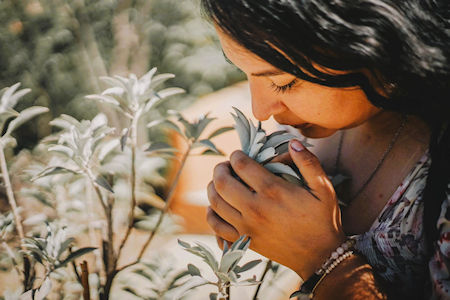
For ten thousand years the ancestors of the Kumiai people have lived in Baja California, extending into southern California to the Salton Sea. They lived in right relationship with the land as they were hunter/gathers and moved seasonally for food and wild game. They built only small stick huts and then burned them when they left, leaving behind no foot print. They did not rule over nature. The ancestors learned all the qualities of the native plants and secrets of life which they passed this on in an oral tradition. The young ones who were taught would one day become the “Keepers of Life.” Their stories passed on what they knew, where they came from, and where they were going. Their stories reminded them of their responsibilities and a way of life.
One day in the late 1800s a young Kumiai man, Julián Domínguez, left the mountains near what is now Mexicali. He was looking for a place with warmer winters, fertile lands with running water and an abundance of wild game. We will never know the footsteps he took or how long it took him to find his dream in the Guadalupe Valley. What he found was a beautiful hidden land sheltered in the foothills and mountains east of the Pacific, yet close enough to the ocean to make a journey for fish and to collect the sea’s bounty. There were dense groves of coastal live oak trees and collecting the acorns was an essential food source. He built a small hut of branches from the oak trees for his sturdy wife, Maria Ortiz, who gave birth to fourteen children. The first born was named Agustín Domínguez Ortiz, followed by a brother, Jorge Dominguez Ortiz.
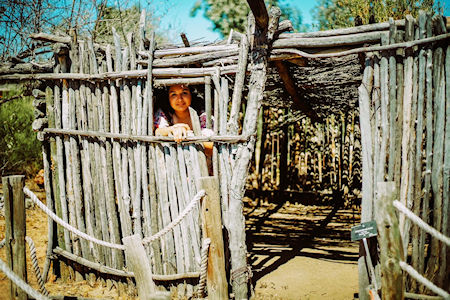
Julián was not the first. Kumiai San Antonio Necua village was established 2000 years ago. Julián founded his home here. As time passed, he became known for his “big medicine.” He called people together near a little oak tree, he called, “The Meeting Tree.” These counsels were very important for all tribal matters to be worked out in peaceful ways. Julián began to teach his sons how to sustain life and to know the deep spirit in nature itself. As the family grew, a baby girl was born to one of Agustín’s younger brothers, Jorge, whose son had a baby girl named Carmen, the great granddaughter of Julian. She was named Carmen. She was a curious little one and loved her grandfather, Jorge, so much. When Carmen was 5-years-old, Jorge the elder saw she was ready to learn the Native ways.
Today, I travel out to Necua to meet Carmen Dominguez, the granddaughter of Julián, and Mirna Borrego my friend and translator for this story. It is a hot September day. All the vegetation is dry and dusty and the grapevines are dropping their brown leaves. Just beyond Doña Lupe’s vineyard is a new concrete road to the village. The women met me and we walked through the community center established in 1970 for visitors and tribal meetings. There is a restaurant with a lovely shaded patio, a museum and small gallery. In the gallery you will see the finest handwoven needle baskets which bring income from enthusiastic collectors. Carmen suggested we sit in the deep shade of massive tree out of the sun. I gazed dumbfounded at the size of this magnificent oak. Suddenly overwhelmed I took a step into the deep shade. Carmen watched and told me that I was entering the shade of Julián’s 200-year-old “Meeting Tree.” This living tree had witnessed the history of Necua’s people. There was a palatable shift in energy as if the very leaves held the songs of the old ones.
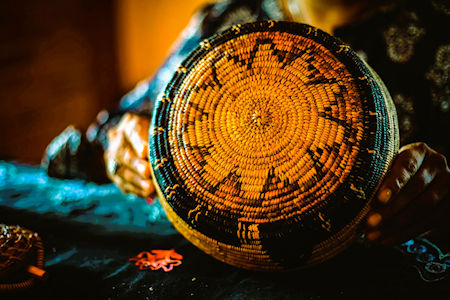
Carmen continues her story standing near the trunk of the old oak. She spoke softly in reverently fluid Spanish, while Mirna translated, “Grandfather taught me how to read people, to feel their spirit, how big their hearts were to learn. He healed many people, but these were always done in private. There were many blessings and teachings also done in private. He told me many more secrets than just the plant medicine.” Mirna said that Carmen also learned how to manage the animals and the horses and she knows how to do this without violence. Carmen continues, “The most vivid memory is one when my horse got sick, he taught me how to heal it with medicinal plants.” It can be said that Carmen learned the ways of the horse whisper, “It is like I feel my communication inside go to the inside the horse.” A cool breeze moves through the oak leaves as it has for centuries. We stop to listen and appreciate the gift from the ocean. Carmen speaks, “He taught me about life beyond what I can see and his stories were astonishing. He taught me with a smile.” Then Carmen’s voice changes as her Spanish is filled with love, “He taught me everything I know.”
After Julián’s death, Agustín was chosen to become the chief of the Necua. He faced a different kind of challenge than his father. Baja was growing with the new technology. The way of life surrounding their village began to change very rapidly. Fewer Kumiai youth were interested in the native wisdom; choosing to gain information, but not necessarily wisdom, through the internet. This is a serious problem for any community. But in an oral tradition if the wise elder cannot pass on the stories, it is as if a great library of ancient knowledge burns to the ground. Agustín died September 2024.
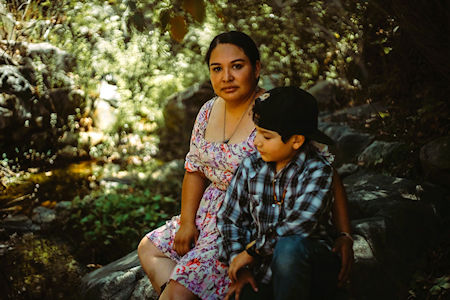
Mirna translated gently, what Carmen shared, “When my uncle died this year, I cut my braid and gave it to him when I said goodbye, as a symbol of asking him for permission to continue in the earthly realm as his guide to knowledge.” As Agustín lay in the hospital, the powerful Kumiai singers met beneath this very oak. Using heavy gourd rattles to accompany their deep male voices, they sang for Agustín to have an easy journey home.”
Mirna shared that Carmen, now 28, is married and the mother of two boys. She is the only person from Agustín’s lineage who knows the secrets. She calls herself a Keeper of Life. Carmen cannot become chief of the Necua Kumiai because only the men of the tribe can be honored in this way. Carmen admits she sometimes feels a little lonely carrying the weight of this knowledge into a challenging future. She reaches outside the community to find others who know how important it is to not lose thousands of years of knowledge. Mirna shared, “It is a true challenge for her to see how the younger generations have lost interest in learning the native language, the customs, and traditions of their ancestors.” Mirna, a Mexican national and has become a good friend. She feels honored to be learning the ways, “Carmen has taught me words and prayers in her native language, I’ve learned how to collect acorns from oak trees, and I’ve learned how to walk among the ivy with respect and introduce myself to it. When I lost my grandmother, Carmen gave me a tea to calm my heart, and I have offered this medicine to my loved ones. More than anything, Carmen has taught me loyal friendship.” Mirna continues with deep affection, “Carmen is a strong woman, with a huge spirit, like that of a great mother bear.”
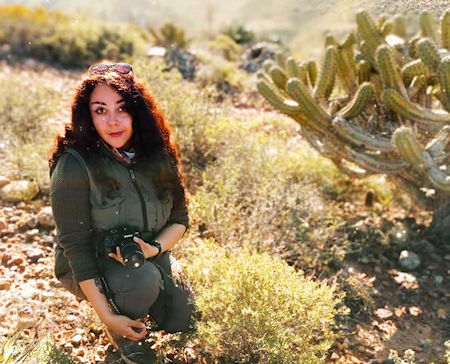
I asked Carmen what she might like to share with those who read this story, she smiled and answered, “Be Happy. A happy heart is the most important thing. Check to see if the life you are living is making you happy and then live it with your whole heart.”
Info to visit: To visit the Kumiai village, its museum and shop, follow the "Ecoturismo Kumiai" signs past L.A.Cetto and Doña Lupe a couple of kilometers. The restaurant and museum are open on weekends, but the village can be visited any time. They hold a special ceremony every June 13th.
Related articles:
Terra Peninsular: The Way of the Guardian
Native Kumiai Finding a New Way
Kumiai Celebration
Visiting Kumiai Territory